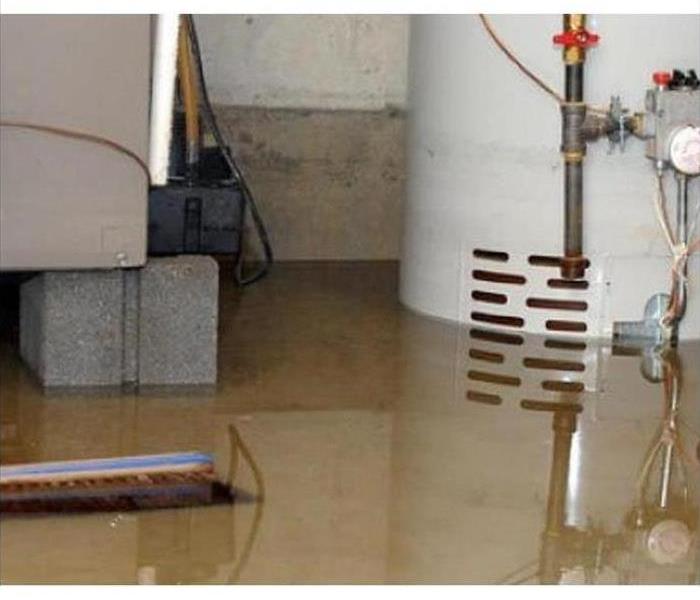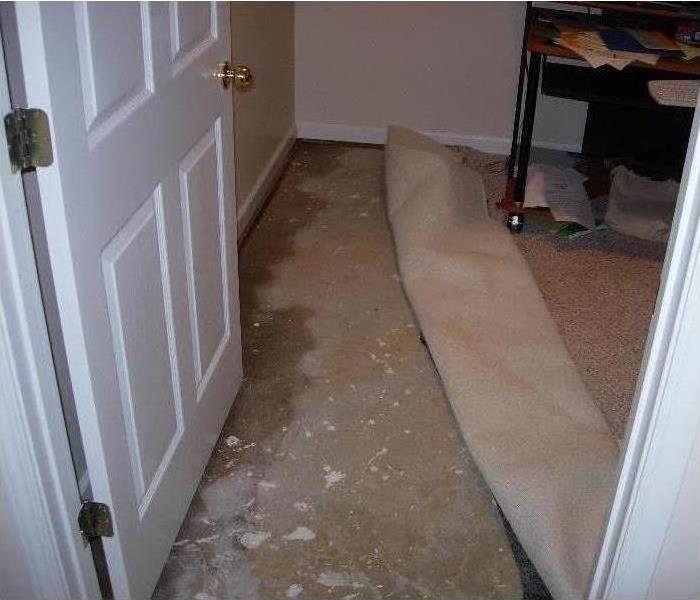Recent Water Damage Posts
Restoring and Repairing your home cost effectively
12/18/2023 (Permalink)
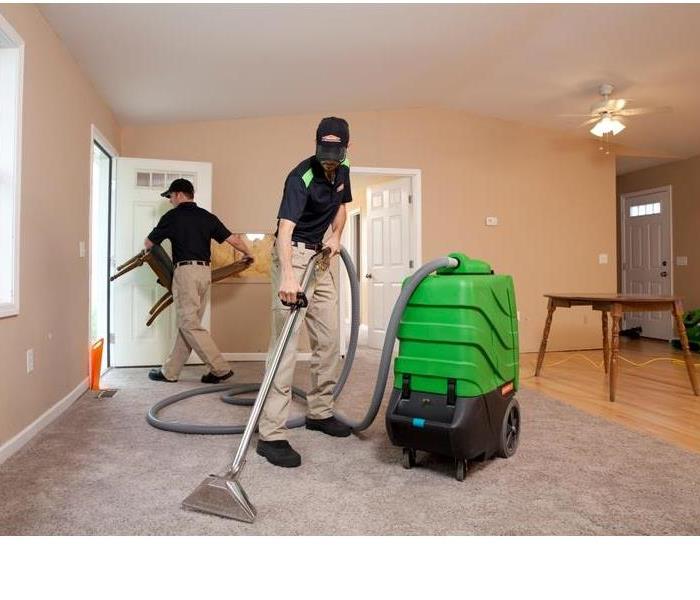 SERVPRO is here to help with all your Restoration and repair needs after a flood
SERVPRO is here to help with all your Restoration and repair needs after a flood
Restoring and repairing a home after flood damage requires a comprehensive approach to ensure efficiency and cost-effectiveness. Understanding the complete flood restoration process is crucial in engaging the right professionals for this daunting task. It encompasses various stages of repair and cleaning, all of which our team of qualified experts is equipped to handle. Recognizing the significance of professional assistance in returning homes and businesses to their preloss condition is paramount.
In addressing flood damage, prompt action is imperative, starting with containment and emergency services. These initial steps are crucial before mitigation or scoping of the job. Effective planning precedes the restoration process, but certain immediate actions cannot be delayed and need inclusion in the overall restoration plan. Our team employs efficient strategies, commencing with communication through our SERVPRO emergency line.
The gathering of information about the disaster is pivotal. Our professionals rely on data shared through our emergency line to prepare adequately. Thorough details enable us to mobilize the right personnel, equipment, and products from our warehouse. There are three primary ways we gather essential data for formulating a restoration plan:
- Emergency Phone Call: Sharing comprehensive information with our emergency line operators prepares our technicians for the situation awaiting them.
- Job Scoping: Our experienced project managers assess the flood-damaged property, determining necessary actions for restoration and documenting losses or additional measures needed.
- Customer Conversations: Leveraging the customer's insights helps prioritize actions during the restoration process.
Creating staging areas is an efficient approach our SERVPRO technicians utilize. These areas, set up in unaffected sections of the home close to the damaged areas, facilitate easy access to equipment and protective gear. This practice minimizes trips in and out of the house, ensuring efficiency, convenience, preventing cross-contamination, and proximity to drying/work zones.
Efficient strategies for water extraction are vital due to the potential damage caused by standing water. Removal of standing water is crucial to focus on drying, cleaning, and other recovery actions. Various methods are employed:
- Trash Pumps: These gas-powered pumps effectively remove flood water, including smaller solids and debris.
- Wet Vacuums: Versatile extractors with different attachments suitable for removing water below two inches in depth.
- Subcontractors: In cases of severe contamination, subcontractors may be engaged for handling blackwater incidents.
Numerous initial tasks must be addressed promptly after a flood, bridging the gap between potential contamination and removing bulk materials. Our dedicated team of water restoration technicians and cleaning specialists is committed to restoring the property to its original state seamlessly, ensuring it's "Like it never even happened."
5 Things You Need To Know About Water Damage Statistics
10/28/2022 (Permalink)
When a pipe bursts, a drain backs up, or a flood occurs in your home, it can be hard to see past the mess. A million questions will run through your mind.
What do I do now?
What’s going to happen?
Is my stuff ruined?
And the most important question of all: Will my homeowner’s insurance cover the damage?
There’s no doubt about it. Water damage is extremely stressful, and the more you know about it, the better you’ll be able to decide how to address it. Here are five things that every homeowner needs to know about water damage.
1. There are different insurance policies for flood damage and water damage.
You might think that water is water, whether it’s from flooding or a burst pipe, but flood damage is not covered under homeowner’s insurance. If you live in an area likely to experience flooding, you will probably already have a separate policy through the National Flood Insurance Policy (NFIP). When you report the claim to the insurance company, make sure to specify whether the claim is for water damage or for flood damage, so they can begin adjusting your claim correctly.
2. Not all water damage is covered by your insurance.
It is a good idea to look over your insurance policy and familiarize yourself with any exclusion to your water damage coverage. For instance, most policies cover sudden damage, like water damage from a really bad storm or from an overflowing washing machine. On the other hand, any water damage that happens because you didn’t maintain the property may be excluded, as well as gradual leaks that caused water damage over time.
3. Once water damage has happened, the clock is ticking before it gets worse.
When your property has been water damaged, you don’t have the luxury of waiting around for a convenient time to start the cleanup. Secondary damage from mold growth can present serious health risks associated with mold in the living environment.
Mold spores are everywhere, but they need moisture and a nutrient source to grow. And that is exactly what your wet carpet or drywall offers.
There is a 24 to 48 hour window from the time something gets wet until mold CAN begin to grow. After that time, mold will multiply rapidly. When mold growth is widespread, you may need the services of SERVPRO mold remediation service to safely treat and remove the mold.
To prevent mold growth, you will need to get your property completely dry again within that 48-hour window. To do this, you’ll need to contact a company that specializes in water damage restoration and emergency water extraction. They will have the professional water removal equipment and drying equipment to get the job done as quickly as possible. Many have 24-hour a day emergency hotlines, so you can start recovering your property almost immediately.
4. Your insurance company needs to know right away.
It’s a good idea to call your insurance company right away when you discover water damage. Your insurance agent can start the claims process immediately, as well as guide you through the first steps you will need to take to protect your property from more damage, like stopping the source of the water at the main water turnoff.
5. The pollution level of the water is important.
Water damage is categorized as one of three levels by how polluted the water source was that caused the damage.
Category 1: Water from a clean water source, like a fresh water line for a dishwasher. This water will not cause illness or any ill effects.
Category 2: Water that may cause illness through contact. It may have bacteria in it,
Even though water may start out as Category 1, that doesn’t mean it will stay that way. Any contamination that the water touches, such as dirty carpeting or soil from the ground, can change water damage Category to 2 or even Category 3. And since standing breeds bacteria, the longer the water is around, the worse the contamination of your property.
More contamination can mean that the restoration team will have to use more aggressive measures to clean your structure and property, and it might mean that soft furnishings, like your carpet and the carpet pad, may have to be discarded for your safety.
Water damage can be dangerous and expensive, so preventing water damage is an important part of home maintenance. But if you know the basics of what to do once it happens, you can prevent it from doing its worst.
Water Damage Statistics
Water damage covers a broad range of potential loss. Homeowners understand that wear and tear will occur in any circumstance; however, there are a variety of unforeseen events that may trigger water damage. Natural disasters are often given the most blame for water damage, and they should, considering that the majority of damages due to water stem from some sort of outside environmental factor.
Nevertheless, water damage may come in a variety of forms. Understanding the sources of this type of damage is important to not only potentially preventing an incident, but more importantly, to understand where you stand in the eyes of your insurance provider. Water damage in homes most typically comes from the following causes:
- Frozen pipes
- Leaking pipes
- Leaky roof
- Broken washing machine hose
- Plumbing problems
- Insulations issues
The water damage statistics below will highlight the widespread nature of this issue. While many people do not view this as a common occurrence, water damage accounts for a significant number of homeowners insurance claims. The following are some of the most interesting water damage statistics:
- Almost 40 percent of all homeowners have said that they have experienced loss from water damage
- About 93 percent of all water damage can be prevented
- Water damage is the second most frequently filed insurance claim in the United States
- 250 gallons of water is released a day due to a 1/8-inch crack in a pipe
- About 20 percent of all insurance claims related to water damage of some kind
- Billions of dollars in property losses are spent each year as a direct result of water damages
Those homeowners with an understanding of the prospective damages associated with water are much more likely to stop problems before they become major issues. Hopefully these water damage statistics were able to shed some light on the vast complications that may arise from water in the home. If you or your family has experienced water damage and are looking to file a claim, contact Arguello, Hope & Associates for more information.
To get started today, simply fill out a Free Case Review form on this page.
Water Damage Insurance Coverage
First and foremost, homeowners must maintain an understanding of exactly what is and is not covered under their current insurance policy. Without this knowledge, homeowners will be left in shock when disaster strikes and they must pay for these damages out of pocket. Besides purchasing a flood policy for protection, you may be able to add coverage to your existing policy. These additions may cover things such as the following:
- Mold remediation (varies on state)
- Backup of drains or sewers
- Plumbing water damage
- Air conditioning damages
- Water heater damage
Homeowners must be astute in recognizing water damage as early as possible. When a sudden storm, plumbing issue, or sewer backup occurs, knowing what will be covered will ease stress and make the entire repair process much more fluid. To find out more, contact our SERVPRO!
Cost Effective Water Remediation
9/20/2022 (Permalink)
Many steps can be taken to make the restoration and repair of a flood-damaged home more efficient and cost-effective.
Understanding the full measure of the flood restoration process for your home can ensure that the appropriate professionals get called to respond to these disasters when necessary. Flood restoration involves multiple repair and cleaning stages, both of which our extensive roster of qualified professionals can provide. Understanding what is involved in returning your home to a preloss condition after a flood can show homeowners how vital professional recovery actually is for residences and businesses alike.
When considering how extensive flood damage inhomes can become, containment and emergency services become vital efforts to begin immediately. Often, these preliminary tasks occur before mitigation or the job scoping phase. Planning is a considerable step and stage before restoration begins, but there are specific actions they cannot wait to be included in this overall restoration agenda. We have several efficient strategies beginning with your communication with our staffed SERVPRO emergency line.
When is the Information About the Disaster Gathered?
As you might expect, our professionals cannot know about damages to your specific residence without first notifying our administrators about the issue. The information you share with our staff emergency line representatives is shared directly with the appropriate parties responding to the disaster. At this stage, it is critical to be as thorough as possible so that we can collect the proper data and relevant facts to ensure that our technicians mobilize from our warehouse with the right equipment, personnel, and products. There are three ultimate ways that we collect the bulk of the data necessary to form our restoration plan for the property:
- Emergency Phone Call – As already discussed, the more that you can share with operators on our emergency line, the better prepared our technicians are for what to expect when we reach the property.
- Job Scoping – We have highly trained project managers who walk through the property damaged by a flood to determine what actions must be taken to restore the home. We can also use this phase to document total losses of structures and contents or indicate where further measures might be required in these areas.
- Conversations with the Customer – No one knows your property as well as you do, so we often lean on the information provided by our customers to prioritize what actions get taken first.
What is a Staging Area?
One of the efficient recovery approaches that our SERVPRO technicians utilize is staging areas. These get constructed in unaffected areas of the home nearby to where the bulk of the work and cleaning must occur. The objective of establishing a clean room to store equipment and personal protective gear is to have these items accessible as they are needed. We can limit trips in and out of the house by bringing in all of the necessary equipment, products, and devices into this staging area. The primary advantages of establishing this clean room between your home and its damaged areas are:
- Efficient
- Convenient
- Prevents Cross-Contamination
- Near to Drying/Work Zones
What Are Efficient Strategies for Extraction?
Flood losses can be traumatic events in your house, specifically when standing water becomes a pressing concern. In any capacity, pooling can lead to saturation and absorption into the exposed materials of contents nearby. Extraction becomes a critical effort for our responding technicians because this removes the standing water threat to allow for more focus drying, cleaning, and other recovery actions. There are several extractors common to removing natural flood water from a property, whether inside the house, in the crawl space area, or even more inaccessible locations. These approaches include:
- Trash Pumps – Gas-powered trash pumps can often be an ideal choice for removing natural flood water because of these units’ ability to remove smaller solids and debris.
- Wet Vacuums – Extractors like wet vacuums are a more versatile choice, as these can run several different attachments such as carpet wands, squeegee wands, or work independently to remove water below two inches in depth.
- Subcontractor – Threat of contamination can be a motivator to choose a subcontractor where blackwater incidents might be overwhelming for the equipment available to our SERVPRO team.
Many initial tasks must occur between the potential for contamination and leftover bulk materials immediately following the disaster. Our team has motivated and helpful water restoration technicians and cleaning specialists to help address drying and restoring the property “Like it never even happened.”
Prevent Water Damage to Your Furnace This Winter
9/16/2022 (Permalink)
Every winter, especially if you live in a cold climate, your home is under assault from the elements. Eventually, that constant assault can cause your home’s systems to fail. One common result of these failures is water damage. And while any type of water damage is bad, there are certain types of damage that can be worse than others. That’s especially true in the winter.
Perhaps no system in your home is more important in the winter than your furnace. Without it, you’d be in big trouble. So while the impact of home water damage is bad no matter how you look at it, having your furnace damaged when the temps are freezing outside can be catastrophic. So let’s talk about things you can do to protect your furnace from water damage should the worst case scenario happen to you this winter.
Furnaces are hidden from view for a reason. They’re not exactly focal points of a home you want people’s eyes drawn towards. Whether it’s in a crawl space, basement or mechanical closet, it’s typically in a place you naturally don’t find yourself visiting very often. One way to help protect your furnace from water damage is to create an elevated platform upon which the furnace can sit. If it’s the case your furnace is found in an unfinished basement, you can simply pour a concrete block and install the furnace there. If it’s in a closet, it may make more sense to create a wooden box to hold the furnace. In either case, having the additional 18-24″ of height can typically protect against most types of home water damage. Granted, in massive flood events this isn’t going to have much effect, but then again there isn’t much you can do from a preventative stand point when mother nature decides to take charge.
Call SERVPRO for any restoration needs that you may have.
It's The Water You Don't See
9/9/2022 (Permalink)
It's The Water You Don't See...
Even small water damages have the potential to cause serious structural and indoor air quality issues over time.
The key to avoiding costly future restoration is to handle every water problem as a real threat to your property. The proper equipment makes a measurable difference in reducing the damage expense during a water loss. When time matters most, technology and equipment must be counted on to perform.
Here are a few tools used by Professional Restoration Contractors to properly mitigate a loss;
Moisture Sensors- used to detect moisture in carpets, baseboards and walls.
Moisture Meters- used to determine the actual moisture content of various materials. The meter provides accurate readings to monitor the drying process.
Thermohygrometers- measures temperature and relative humidity to calculate and create an environment most conducive to drying. When handling a contaminated loss (CAT 2 or 3), it is not only important to dry the structure, but disinfect and often deodorize.
Ultra Low-Volume (ULV) Foggers- used to atomize liquid deodorizing agents, producing a fine mist that can easily penetrate the site where odor-causing residues may accumulate. It can also be use to inject fungicides and disinfectants into wall cavities and other hard-to-reach areas.
Thermal Foggers- dispenses solvent-based products by creating a dense fog that consists of tiny particles of deodorant solution that attach to and neutralize odor causing particles.
The bottom line... ALWAYS treat a water damage seriously. Call a professional contractor that is trained and experienced in property damage restoration.
Call SERVPRO of Oconee/South Anderson/Pickens Counties for any restoration needs.
It's the Water you Don't See
8/22/2022 (Permalink)
It's The Water You Don't See...
Even small water damages have the potential to cause serious structural and indoor air quality issues over time.
The key to avoiding costly future restoration is to handle every water problem as a real threat to your property. The proper equipment makes a measurable difference in reducing the damage expense during a water loss. When time matters most, technology and equipment must be counted on to perform.
Here are a few tools used by Professional Restoration Contractors to properly mitigate a loss;
Moisture Sensors- used to detect moisture in carpets, baseboards and walls.
Moisture Meters- used to determine the actual moisture content of various materials. The meter provides accurate readings to monitor the drying process.
Thermo Hygrometers- measures temperature and relative humidity to calculate and create an environment most conducive to drying. When handling a contaminated loss (CAT 2 or 3), it is not only important to dry the structure, but disinfect and deodorize.
Ultra Low-Volume (ULV) Foggers- used to atomize liquid deodorizing agents, producing a fine mist that can easily penetrate the site where odor-causing residues may accumulate. It can also be used to inject fungicides and disinfectants into wall cavities and other hard-to-reach areas.
Thermal Foggers- dispenses solvent-based products by creating a dense fog that consists of tiny particles of deodorant solution that attach to and neutralize odor causing particles.
The Three Different Categories of Water
8/22/2022 (Permalink)
When a water event occurs in your property, damage to the structure and contents can occur. The type of water that affects a building includes:
Category 1 water originates from a sanitary water source and does not pose substantial risk from dermal, ingestion, or inhalation exposure. In most cases drying procedures are recommended.
Category 2 water contains significant contamination and has the potential to cause discomfort or sickness if contacted by people. For this category, environmental interpretation is critical as drying for some materials is acceptable while removal of others must occur
Category 3 water is grossly contaminated and can contain pathogenic, toxigenic or other harmful agents. In most cases removal is necessary and environmental remediation is necessary.
When a water event occurs a water extraction contractor is generally hired to remove the water. However, the ability of the contractor to identify the water category, deal with the issues of health and safety properly as well as remove or dry out the affected building materials and contents can vary greatly.
Assessment for water damage independently of the water removal contractor ensures that the project is dealt with relative to the category of water, health and safety concerns are identified and controlled and their work product is validated.
Scared of frozen pipes
12/21/2021 (Permalink)
Below a few steps, you can take to help decrease your chances of dealing with pipe bursts as a result of the cold weather:
- Leave the Heat On - This may seem self-explanatory, but if you’re away overnight or gone for long periods of time, setting your indoor temperature no lower than 55°F helps ensure your pipes aren’t as exposed to the cold.
- Insulate Pipes - Though you should always ensure your attic and crawl space are properly insulated year-round, a makeshift quick, and inexpensive way to insulate your pipes would be to wrap pipes in heat take or heat cables with thermostat control. This will work in a pinch, but we recommend properly insulating these high-risk areas.
- Seal Cracks and Opening - To prevent drafts, seal or caulk cracks and openings around windows, doors, dryer vents, water pipes. and sill plates.
Let Faucets Drip - Letting cold water drip from a faucet helps to keep water flowing throughout the pipes. As the water flows, even if it’s just a trickle, it helps to prevent pipes from freezing.
If you do find yourself in a water issue due to busted frozen pipes, make sure to call SERVPRO of Oconee/South Anderson, our water damage professionals are trained and certified to handle any disaster you find yourself in during these colder months.
Three types of water damage
8/20/2021 (Permalink)
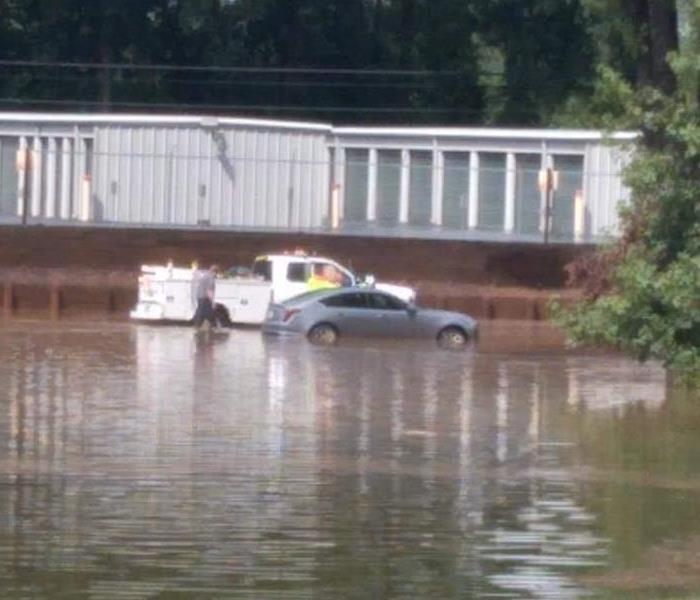 This flood was caused by a recent storm in Oconee County
This flood was caused by a recent storm in Oconee County
The phrase “water damage” is an umbrella term that describes a variety of different situations and conditions. Every incident involving water is unique and its resulting water damage varies. It may come as a surprise that even the water itself can be categorized into a variety of classifications. The Institute of Inspection, Cleaning, and Restoration Certification details three different “Categories of Water” that are involved in water damage in homes and businesses alike. In this blog, we’ll break down these three categories of water, which can help you assess the severity of any water damage that should occur in your home or business.
The IICRC’s 3 Categories of Water
The three water categories presented by the IICRC in its “S500 Standard for Professional Water Damage Restoration” article aim to classify water by its contamination level, “considering both its originating source and quality after it contacts materials present on the job site.” The document also asserts that the amplification of the water’s contamination level can be increased or decreased by both time and temperature.
Category 1- Clean Water
Water that is classified as Category 1 is commonly referred to as “clean water,” as the water’s source is sanitary and does not pose any risks from exposure. Category 1 water examples may include melting ice or snow, rainwater, and broken water supply lines. While it does not appear as though Category 1 water poses a significant risk, this water can deteriorate depending on how long microorganisms remain wet after exposure and the environment’s temperature. If the water develops an odor, its sanitation has likely worsened, dropping its classification to category 2.
Category 2- Gray Water
When water falls under Category 2, it is significantly contaminated. Upon exposure or consumption, humans can experience symptoms ranging from discomfort to sickness. A wide variety of circumstances fall under Category 2, including common household water damage situations like dishwasher discharge, washing machine overflow, and toilet bowl overflows. Category 2 water also includes a few surprises, such as punctured water beds and broken aquariums. Like Category 1 water, this water can also deteriorate to Category 3, also known as “black water.”
Category 3- Black Water
The most severely contaminated category of water according to the IICRC, Category 3 water, is commonly known as “black water.” Water of this category is “grossly contaminated,” according to the IICRC, and sometimes contains pathogens, toxins, or other “harmful agents.” Category 2 water is known to occasionally cause health effects, but upon contacting or consuming Category 3 water, humans can experience very serious health effects. Types of water that fall under this category include sewage, flooding that originates from seawater and rivers, as well as wind-driven rain from tropical storms or hurricanes. It is important to understand that Category 3 water is capable of carrying harmful substances like toxins and pesticides, so it is best to allow a professional to handle the situation.
We Have the Expertise That You Need
Our team of water damage professionals at SERVPRO Of Oconee/South Anderson Countiesabides by the IICRC’s S500 Standards, as every team member undergoes training with SERVPRO Industries Inc., an -IICRC-approved school. When you call us at (864) 916-4160, our team will arrive onsite immediately, identify the category of water damage onsite, and tailor the water damage restoration services to your home or business’ specific needs in accordance with industry guidelines.
Causes of Indoor Flooding
8/20/2021 (Permalink)
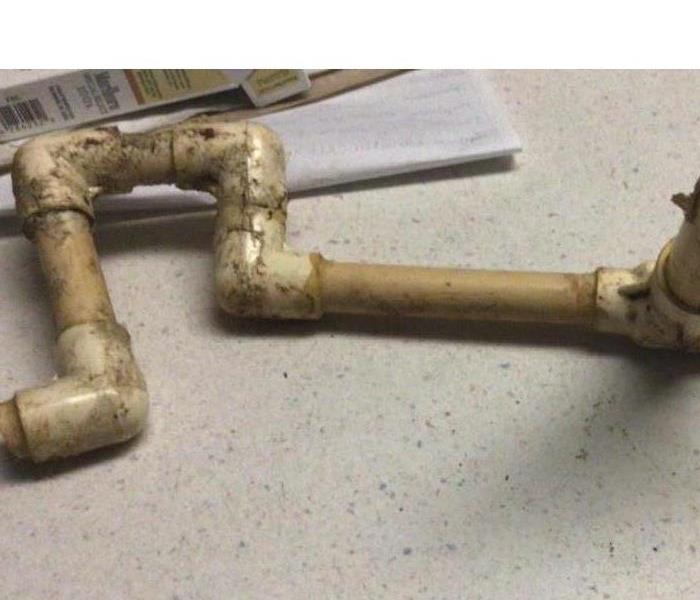 This is a picture of a pipe that broke on the water heater.
This is a picture of a pipe that broke on the water heater.
Water damage usually has one major leading cause: indoor flooding. Some of the most common causes of indoor flooding are:
- Leaky or Broken Pipes: The most obvious cause of indoor flooding is leaky or broken water pipes. Pipes can burst from changes in water pressure or even a faulty setup, but regardless of the cause, pipe problems often cause a ton of damage. Leaky pipes are usually a warning sign of more problems to come. Hidden floods caused by broken pipes in your walls can even create the perfect environment for microbial growth.
- Faulty Washing Machine Hose: The most common problem with watching machines are faulty hoses. A leak in your intake hose can worsen over time and can cause flooding in your home.
- Water Heaters: Even a small leak in your water heater can cause major flooding due to its endless flow of water. Make sure to inspect your water heater on a regular basis, keeping up with maintenance to ensure it doesn’t spring a leak.
- Clogged Sewer or Drain Lines: The flow of water to and from your house can be disrupted when you have clogged sewer or drain lines. Some clogs might be benign, allowing for a slow drain that is merely an inconvenience. But those clogs can get worse over time. The clog can cause your sinks, toilets, and showers to overflow with water, resulting in major damage. This can even include backed-up sewage, causing a hazardous environment for anyone or anything that comes in contact with the affected water.
If you find flooding inside your home, call us and we will be there to help.
Toilet Back Up
8/20/2021 (Permalink)
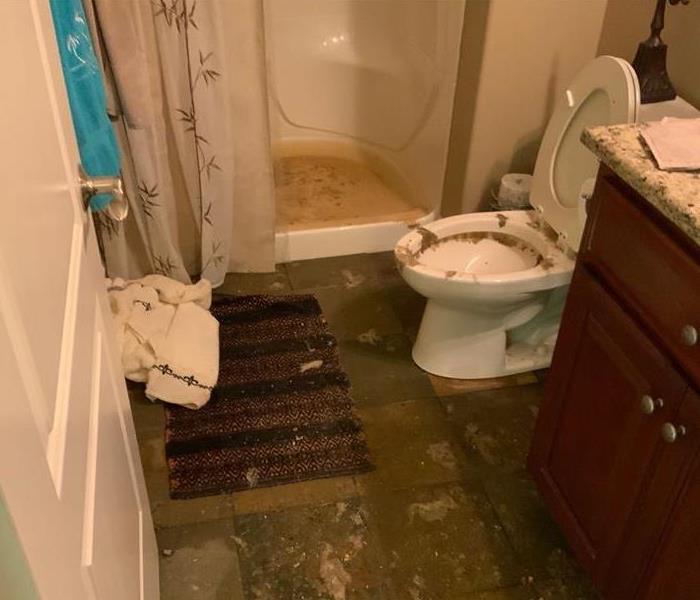 This bathroom encountered a sewage back up
This bathroom encountered a sewage back up
What Causes a Toilet Overflow?
Several different events can trigger a toilet to overflow, including a clogged drain, a blocked vent, and sewage complications.
A clogged or blocked drain prevents proper flushing, causing the toilet to overflow. In this situation, plunging the toilet may relieve the problem.
Every time you flush, air is pumped and needs replacing from the vent pipe. If the vent pipe is blocked, proper flushing isn’t possible and can eventually result in a toilet overflow. This issue usually requires the help of an experienced plumber.
Finally, two issues related to sewage, a clogged sewer line and a full septic tank, can be the catalyst of a toilet overflow. A clogged sewer line occurs when the sewer line becomes blocked by items ranging from tree roots to sanitary wipes. A full septic tank can be problematic, as excess water will have nowhere to go but back up into your home, potentially resulting in a toilet overflow.
24 Hour Emergency Water Damage Service
1/1/2021 (Permalink)
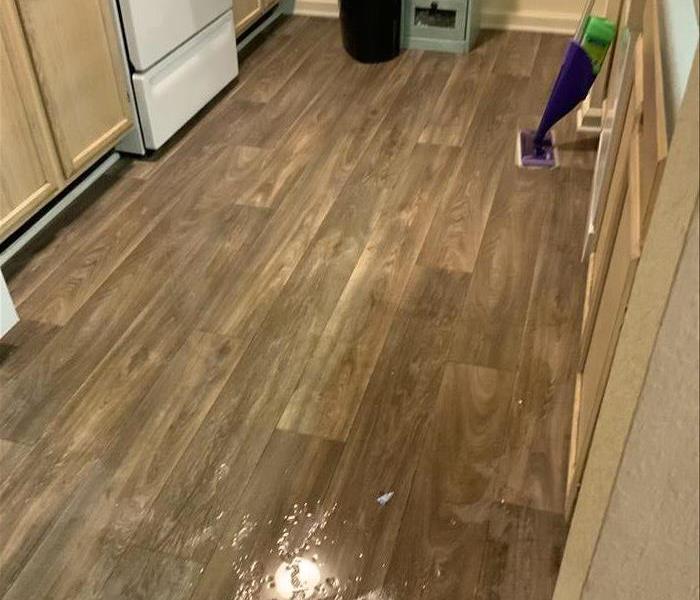 water on kitchen floor due to sewage back up
water on kitchen floor due to sewage back up
SERVPRO of Oconee and South Anderson Counties is available 24 hours a day for water emergencies, large or small. When you are dealing with water damage, immediate action is crucial. A delay of just a few hours can greatly increase the severity of the water damage.
We Answer the Phone Ready to Help
Call Today 864-916-4160
We understand that when you call us, you may be feeling confused, stressed, and vulnerable. You need an expert to guide you through this crisis. SERVPRO of Oconee and South Anderson Counties has the specific water damage training and experience to help you through this tough time. We specialize in water damage restoration—in fact, it's the cornerstone of our business.
What to Expect
When you call, we will ask several questions regarding your water damage emergency. These questions will help us determine what equipment and resources to bring, including how many trained SERVPRO Professionals may be needed.
Our SERVPRO Representative will ask several questions:
- Your name and contact information
- Your insurance information (if applicable)
- The street address of the water-damaged home or business
- When did the flooding or water damage occur?
- What caused the water damage (if known)?
- Is there electricity available (on-site)?
About SERVPRO of Oconee and South Anderson Counties
SERVPRO of Oconee and South Anderson Counties specializes in the cleanup and restoration of residential and commercial property after a fire, smoke or water damage event. Our staff is highly trained in property damage restoration. From initial and ongoing training at SERVPRO’s corporate training facility to regular IICRC-industry certification, rest assured our staff is equipped with the knowledge to restore your property.
Faster to your Oconee and South Anderson County Water Damage Event
1/1/2021 (Permalink)
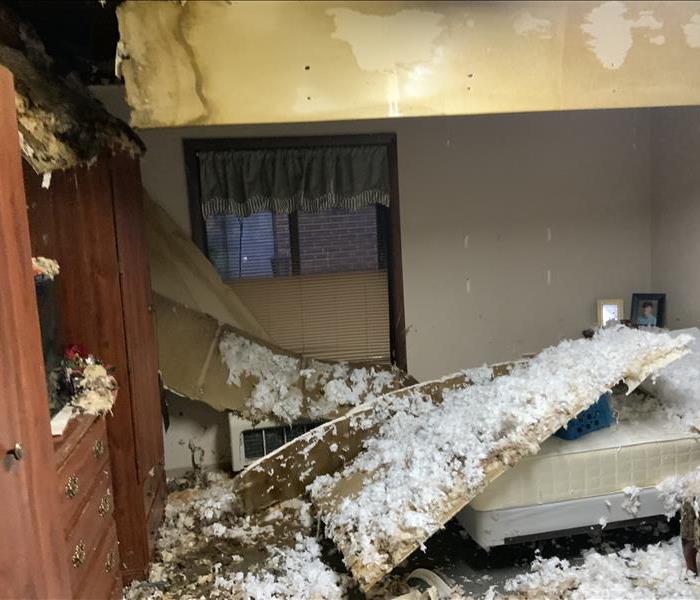 Ceiling fell through due to sprinkler system being broken
Ceiling fell through due to sprinkler system being broken
Flooding and water emergencies don’t wait for regular business hours and neither do we. Oconee and South Anderson Counties provides emergency cleaning and restoration services 24 hours a day, 7 days a week—including all holidays.
Faster To Any Size Disaster
Flooding and water damage is very invasive. Water quickly spreads throughout your home and gets absorbed into floors, walls, furniture, and more. SERVPRO of Oconee and South Anderson Counties arrives quickly and starts the water extraction process almost immediately. This immediate response helps to minimize the damage and the cleaning and restoration costs.
Need Emergency Service? Call Us 24/7 –864-916-4160
Water Damage Timeline
Within Minutes
- Water quickly spreads throughout your property, saturating everything in its path.
- Water is absorbed into walls, floors, upholstery, and belongings.
- Furniture finishes may bleed, causing permanent staining on carpets.
- Photographs, books, and other paper goods start to swell and warp.
Hours 1 - 24:
- Drywall begins to swell and break down.
- Metal surfaces begin to tarnish.
- Furniture begins to swell and crack.
- Dyes and inks from cloth and paper goods spread and stain.
- A musty odor appears.
48 Hours to 1 Week:
- Mold and mildew may grow and spread.
- Doors, windows, and studs swell and warp.
- Metal begins to rust and corrode.
- Furniture warps and shows signs of mold.
- Paint begins to blister.
- Wood flooring swells and warps.
- Serious biohazard contamination is possible.
More Than 1 Week:
- Restoration time and cost increase dramatically; replacing contaminated materials and structural rebuilding may be extensive.
- Structural safety, mold growth, and biohazard contaminants pose serious risks to occupants.
About SERVPRO of Oconee and South Anderson Counties
SERVPRO of Oconee and South Anderson Counties specializes in the cleanup and restoration of residential and commercial property after a fire, smoke or water damage event. Our staff is highly trained in property damage restoration. From initial and ongoing training at SERVPRO’s corporate training facility to regular IICRC-industry certification, rest assured our staff is equipped with the knowledge to restore your property.






 24/7 Emergency Service
24/7 Emergency Service

